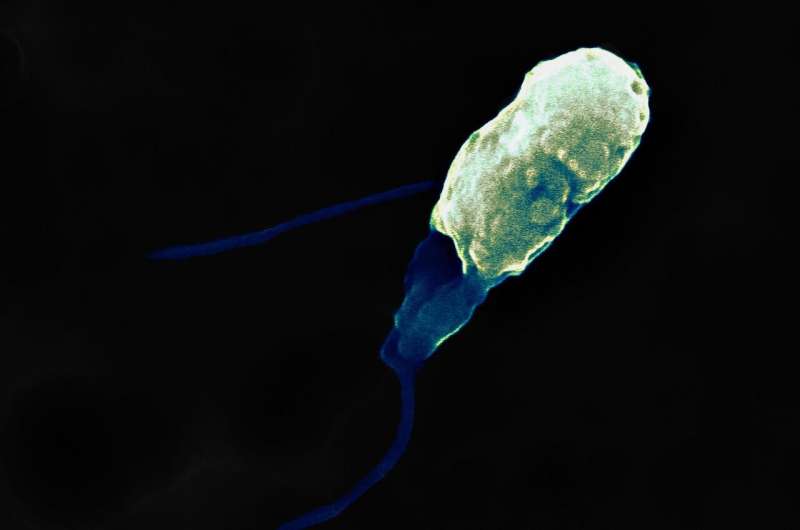This article has been reviewed according to Science X's editorial process and policies. Editors have highlighted the following attributes while ensuring the content's credibility:
fact-checked
peer-reviewed publication
trusted source
proofread
Study illuminates cues algae use to 'listen' to their environment

Plants have long been known to release chemicals to respond to stress and relay information to their neighbors. A team of scientists from Bigelow Laboratory have shown that glaucophytes, a small group of single-celled algae distantly related to plants, appear to have the same penchant for chemical communication. This suggests that the ability to use chemical cues in this way may not be unique to complex life as once thought, but rather evolved further back on the tree of life.
"We're looking at this organism that shares ancestry with plants, and uses a communication process that people once thought only plants used," said Senior Research Scientist John Burns, a co-author on the study. "It's possible that many branches of life started with similar tools for communication but then diverged in the particular genetic way they do it."
Discovering how cell communication works in new lineages helps scientists understand how these abilities emerged and have changed over time. Microalgae, like glaucophytes, are also essential to biogeochemical cycling in aquatic systems so understanding them is essential for predicting how the larger ecosystem functions, especially in stressful situations.
"The underlying communication process used by plants and glaucophytes is similar, and they're based on the same basic components of life," said Baptiste Genot, a former postdoctoral researcher at Bigelow Laboratory and the study's lead author. "But going beyond plants to understand how single cells like these algae carry these processes out is really paving a new trail."
Their results were recently published in The Journal of Eukaryotic Microbiology.
Scientists have long understood that plants emit informational molecules, like hormones and other organic compounds, as a way to communicate information and adapt to stressful situations like changes in temperature or exposure to toxins. But there's far less information on the strategies used by microalgae, despite them being the most abundant primary producers in aquatic systems.
That includes glaucophytes, one of the three main lineages in what's called the Archaeplastida. Organisms in this group, including plants, as well as green and red algae, are known to have a common ancestor over a billion years ago.
Understanding commonalities between the complex communication strategies used by these different organisms can help scientists map the timeline of when lineages branched off from each other. It can also help them better understand how the tools used for photosynthesis evolved.
"Glaucophytes are this other branch of life that developed chloroplasts at the same time as plant ancestors did, but ran with it in a whole different evolutionary direction," Burns said. "So, you can use these comparisons to answer really basic questions about photosynthesis across all branches of life."
The researchers focused on one species of glaucophyte, called Cyanophora paradoxa. They found that, in response to external stressors like changing light, C. paradoxa produces potent hormones like ethylene, which plays a key role in fruit ripening and is known to be released by plants in response to stress.
When the team supplied the algae with a chemical that's a precursor to ethylene, they found that the glaucophytes produced large quantities of the hormone, and slowed down their growth rate in response.
"If you looked at the genes plants have, you would never think that glaucophytes could use these same signaling pathways, because they just don't have the same 'parts,'" Burns said.
"We often use plants as our baseline for photosynthetic life, but, in this story, they're the 'weirdos' who took off in a different evolutionary direction. Glaucophytes may have more in common with other algae than plants do when it comes to these behaviors."
This study provides the first evidence of glaucophytes releasing hormones as a stress response, but questions remain about how these organisms change their actual behaviors, like how they swim or develop, in response to these hormones. Burns and Genot are also interested in how other organisms in the ecosystem respond to these chemical shifts, and whether other algae species use these same hormonal cues for communication.
Beyond communication, though, the study also highlights the value of glaucophytes more broadly. Because of their unique place in the tree of life, how stable they are in the lab, as well as how fast they grow—Burns likens them to "weeds"—they're a valuable tool for answering questions about evolutionary history and even developing algae-based products like plastic alternatives.
"The knowledge gap between what we know about these unicellular, photosynthetic eukaryotes and cultivated plants is still huge," Genot said. "It's challenging but exciting because we have so much more to learn about these little cells living all around us."
More information: Baptiste Genot et al, Functional stress responses in Glaucophyta: Evidence of ethylene and abscisic acid functions in Cyanophora paradoxa, Journal of Eukaryotic Microbiology (2024). DOI: 10.1111/jeu.13041
Journal information: Journal of Eukaryotic Microbiology
Provided by Bigelow Laboratory for Ocean Sciences



















